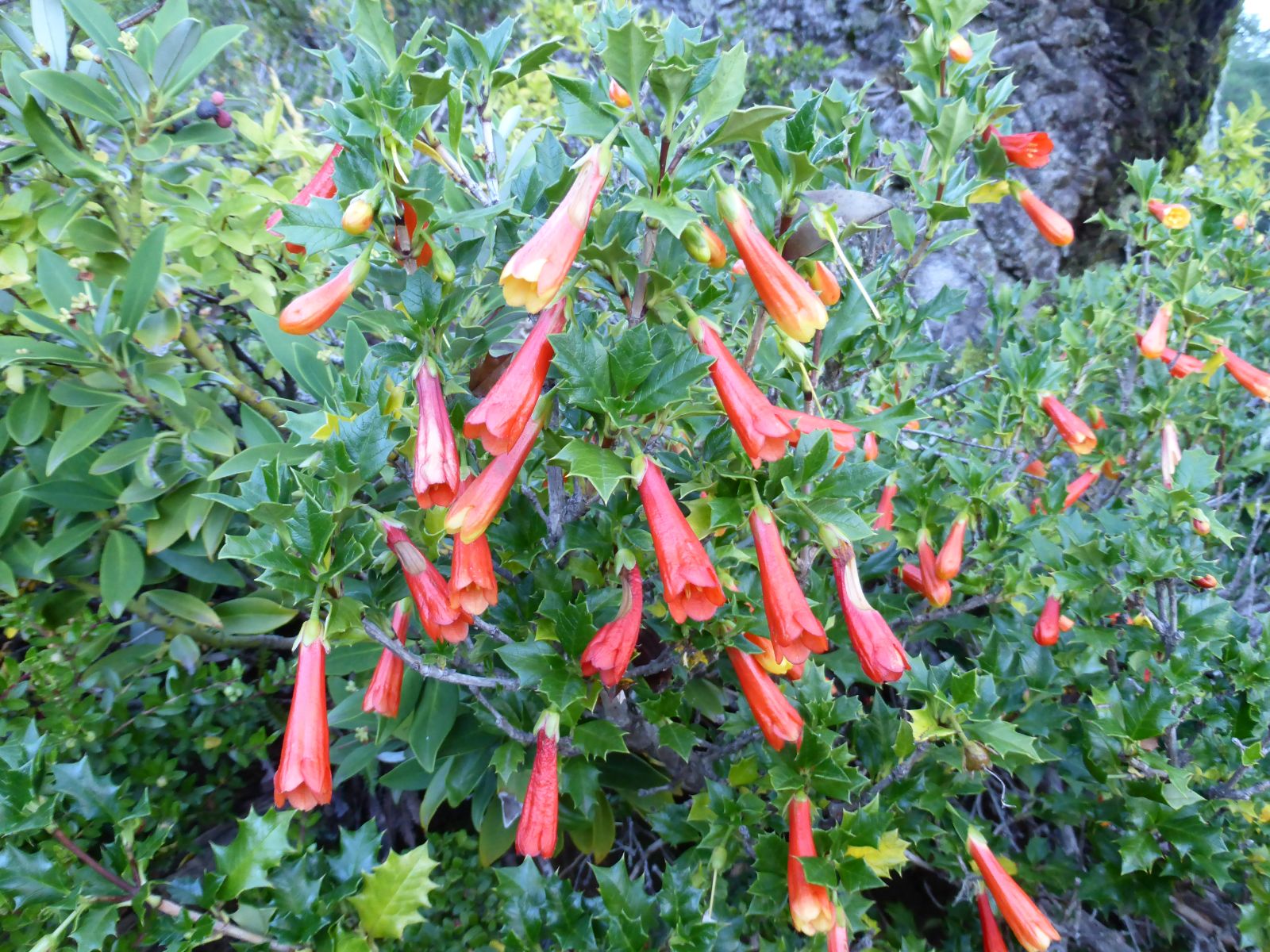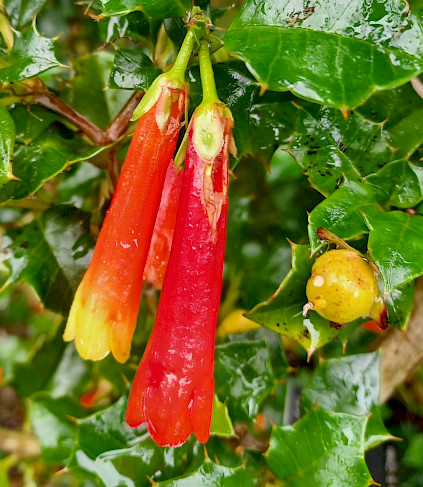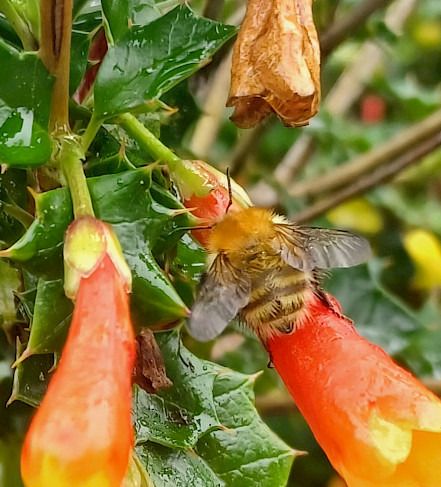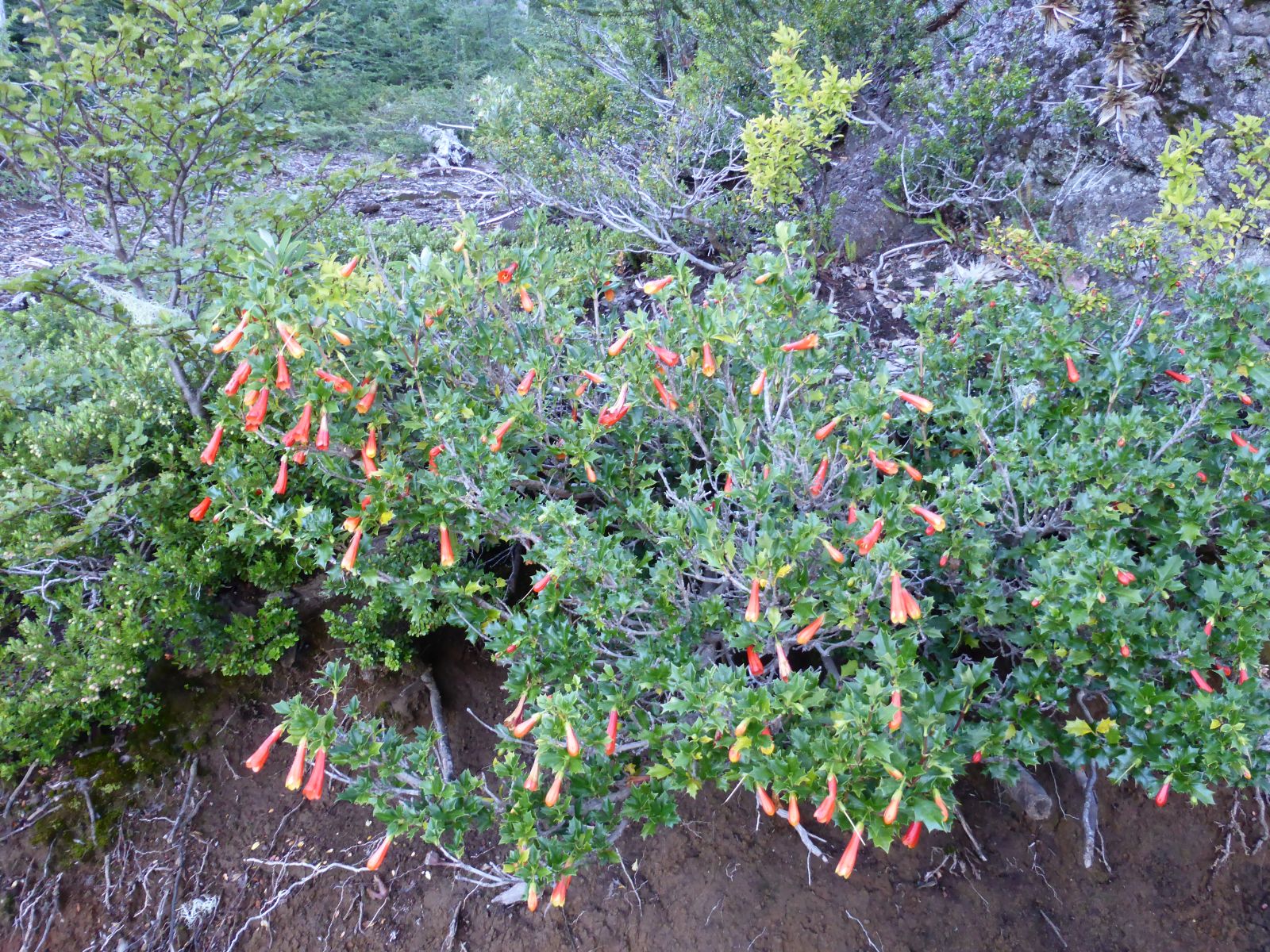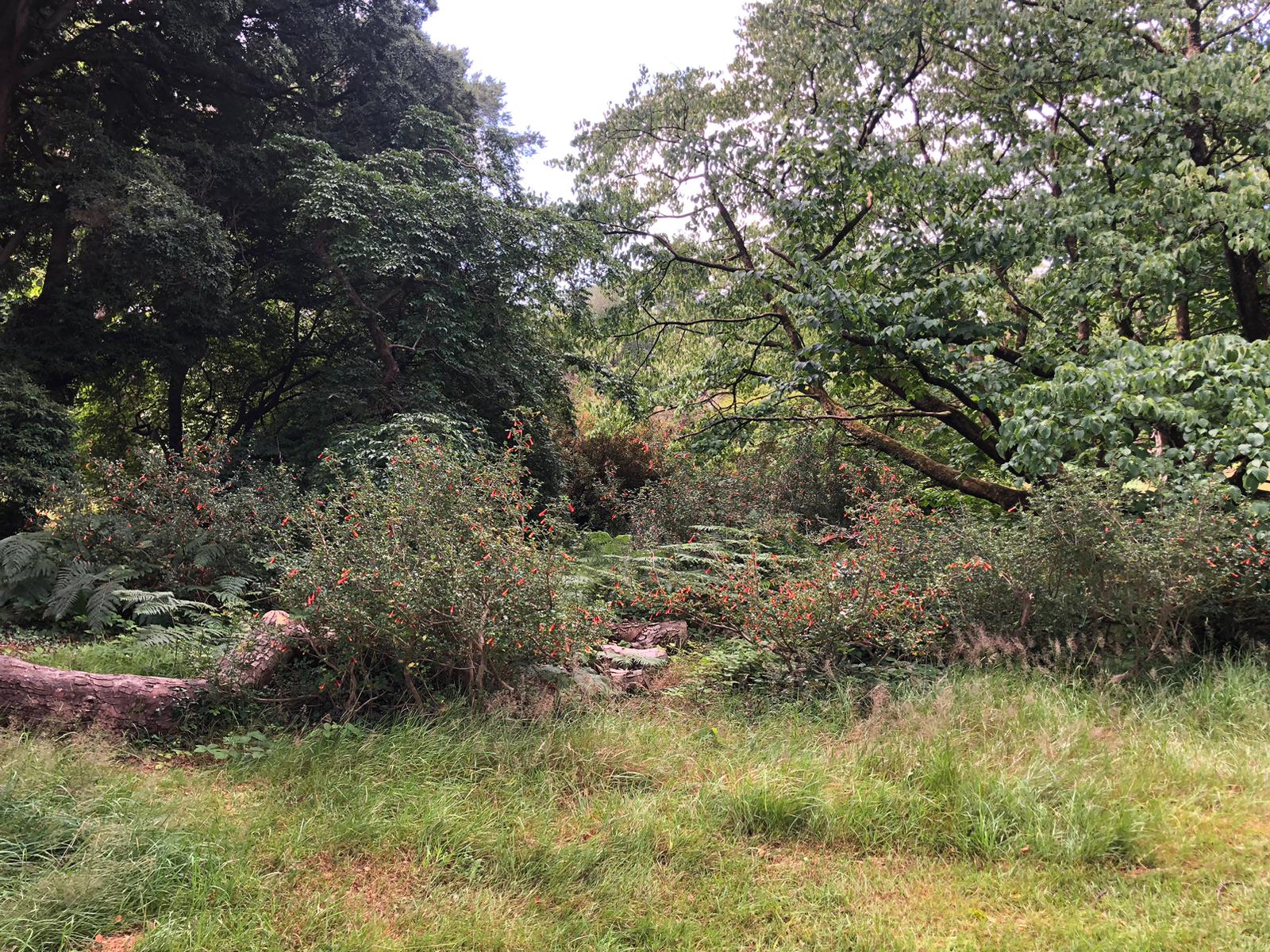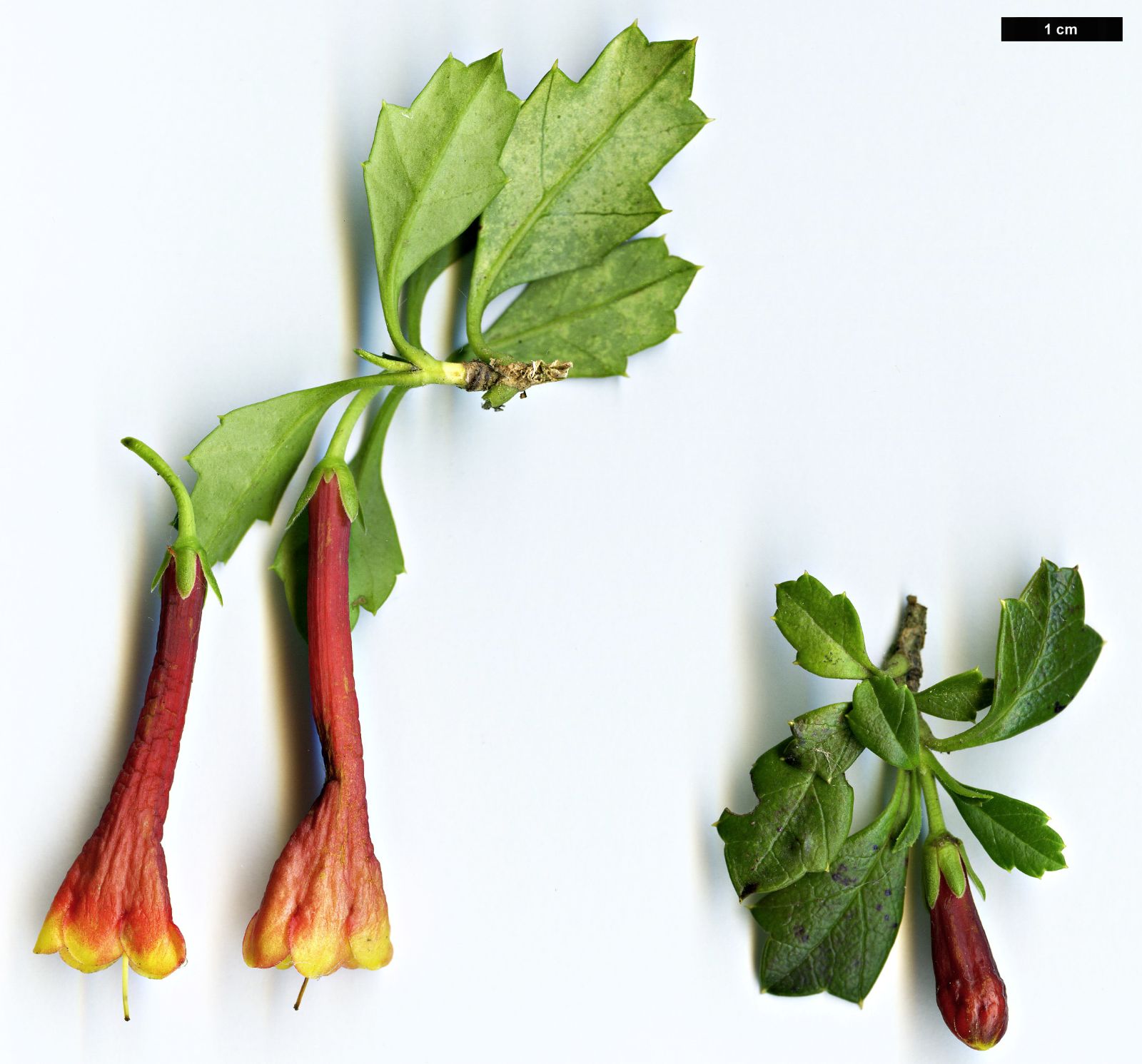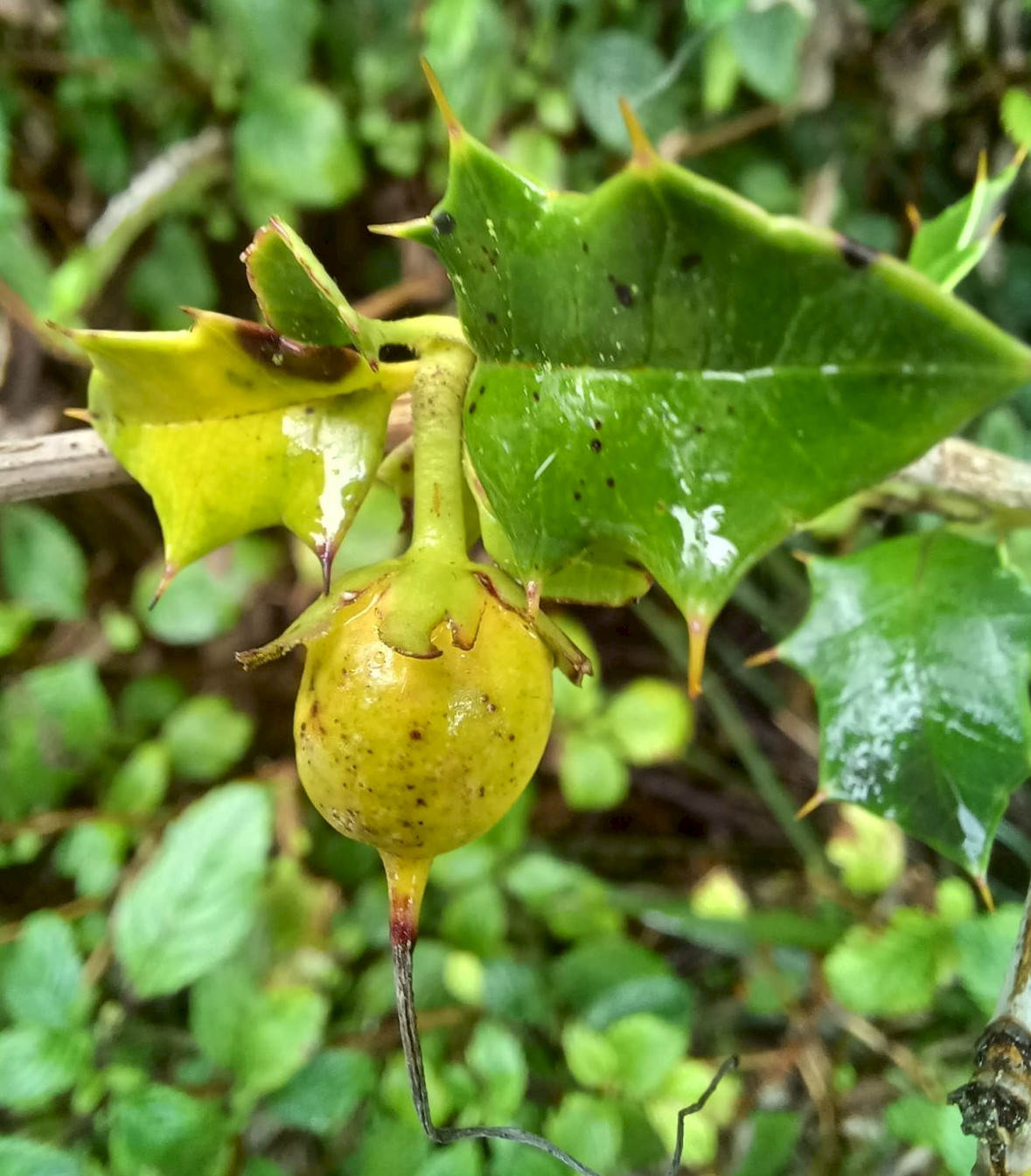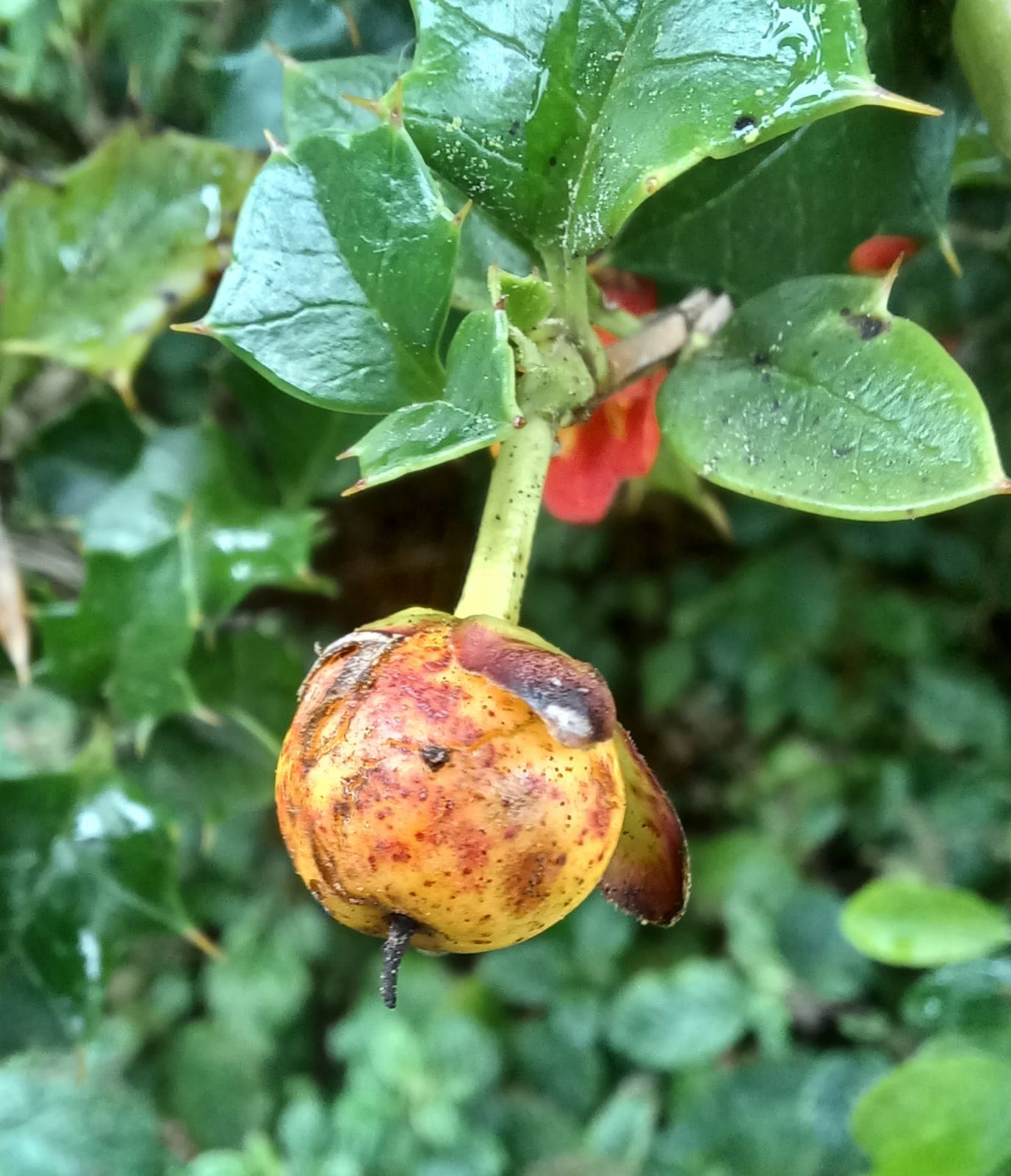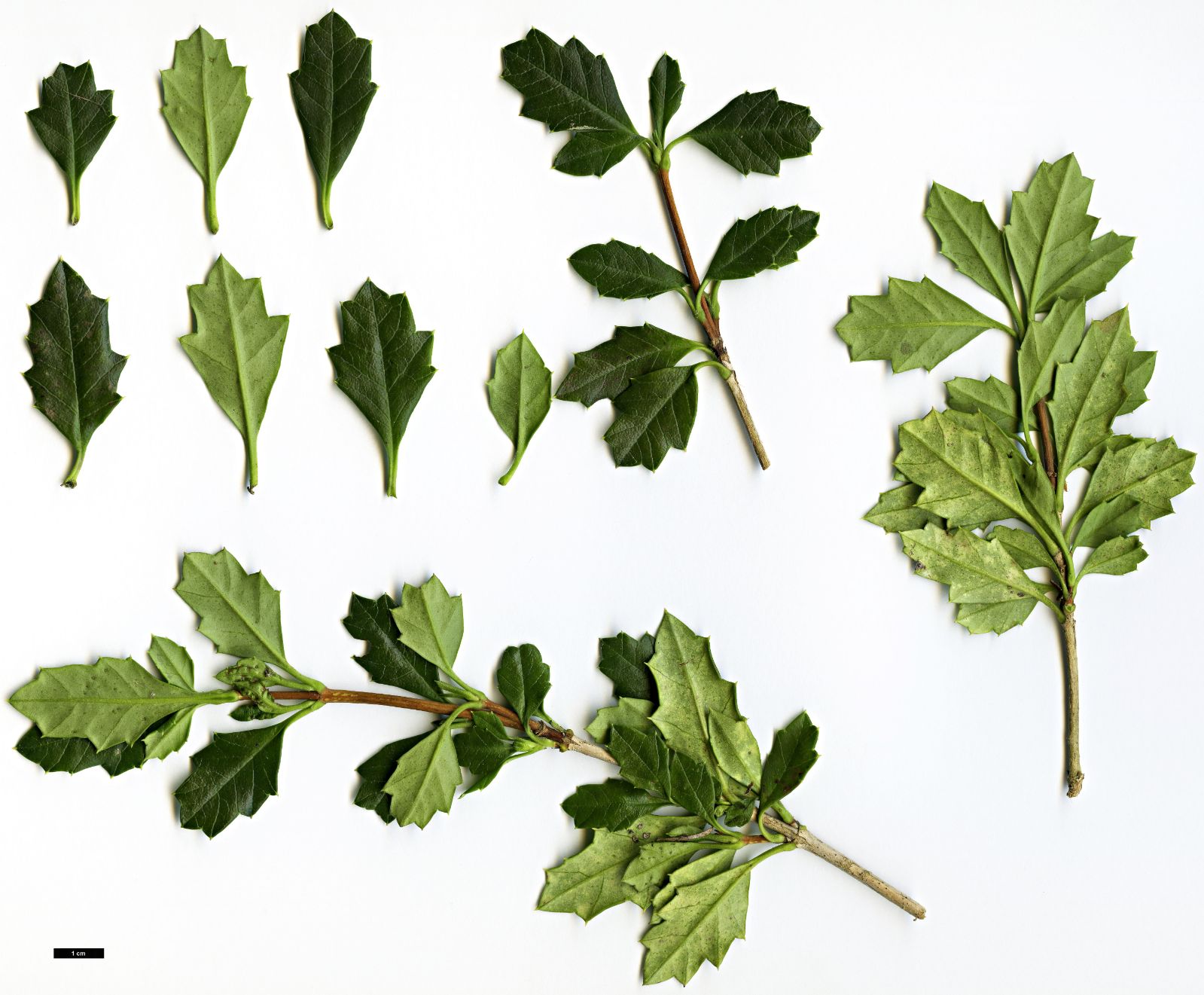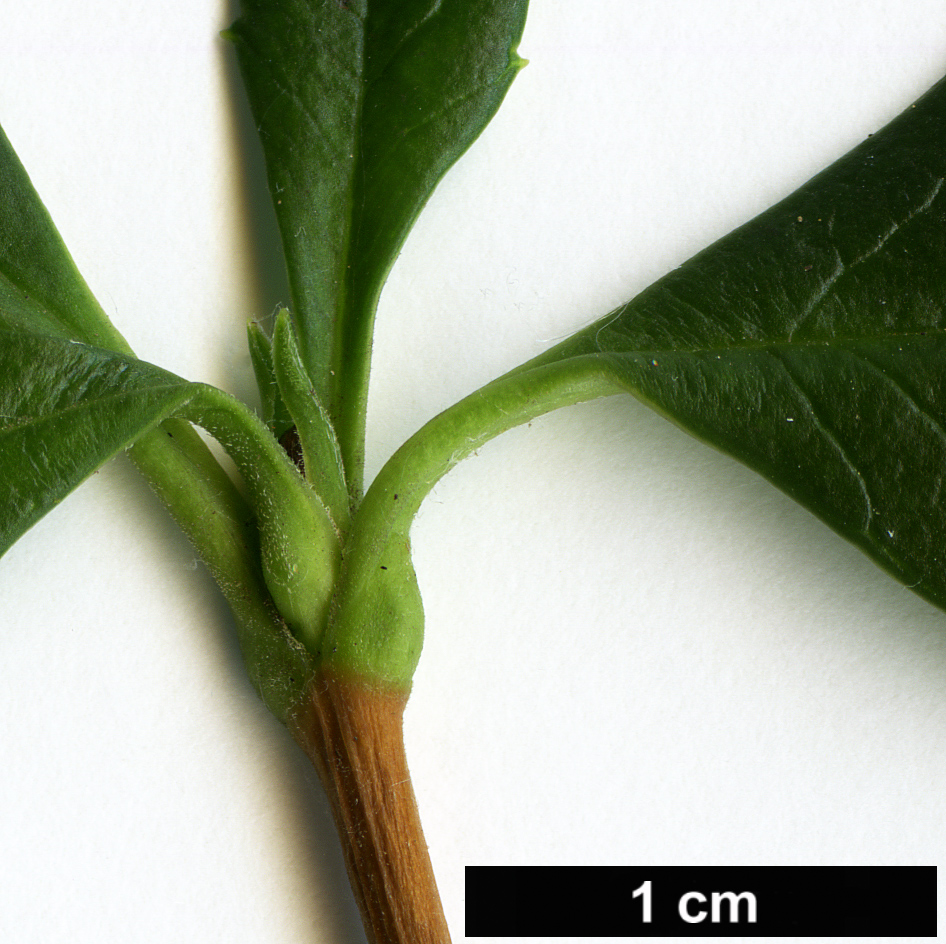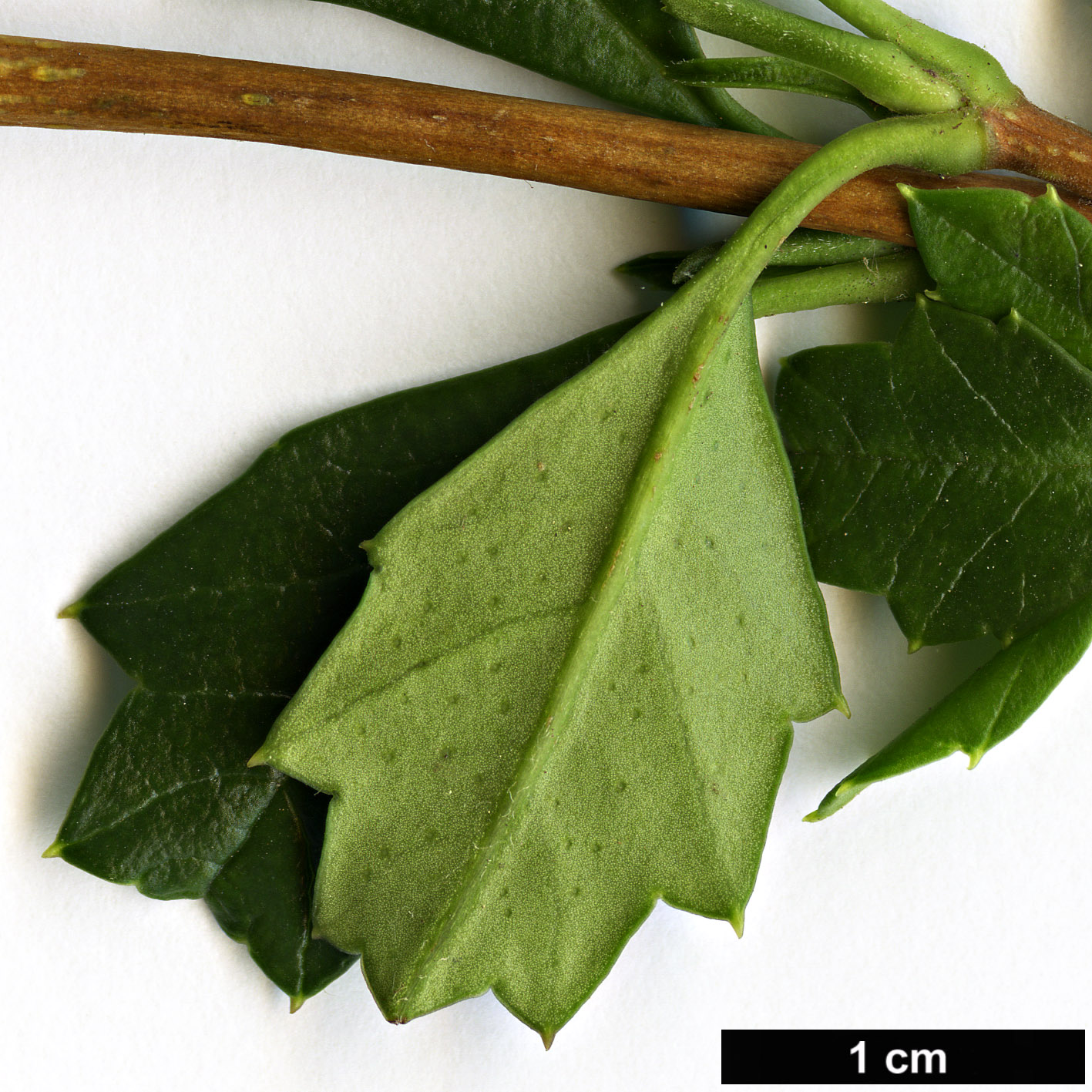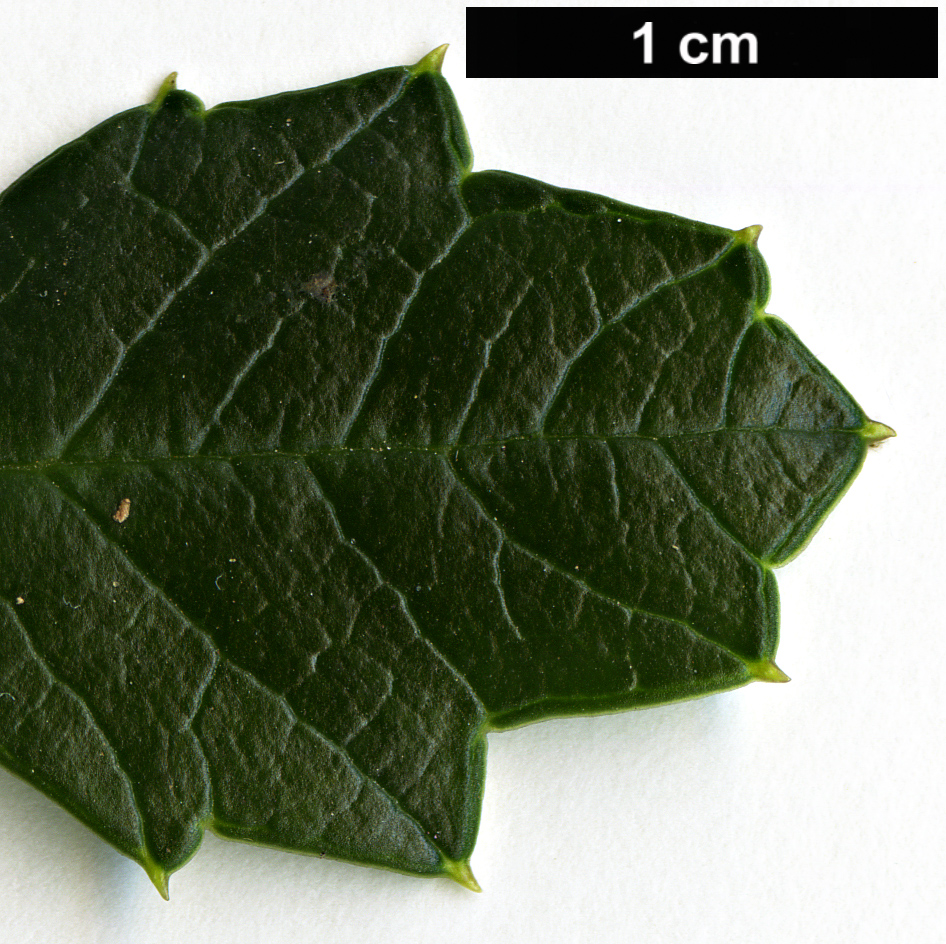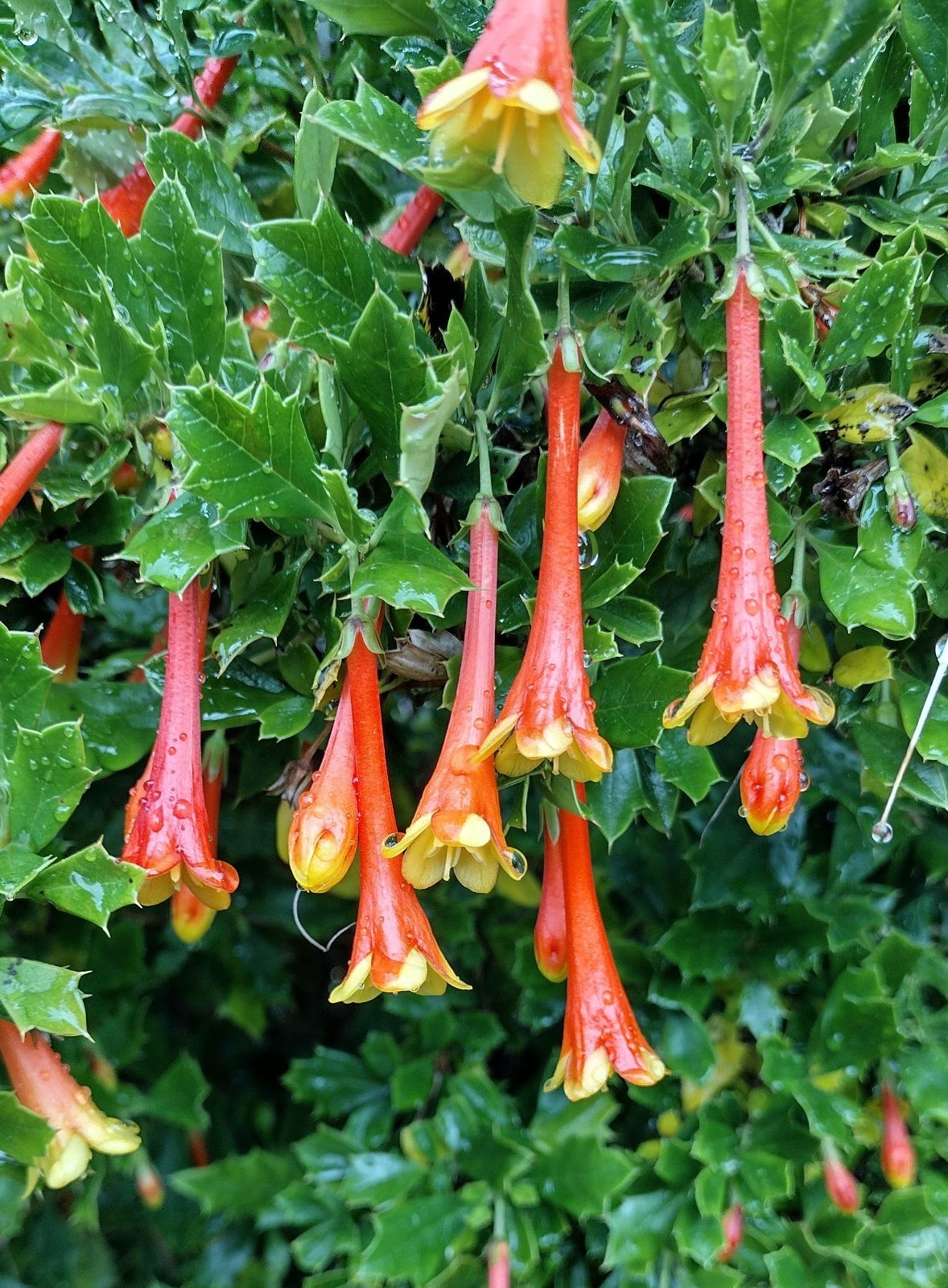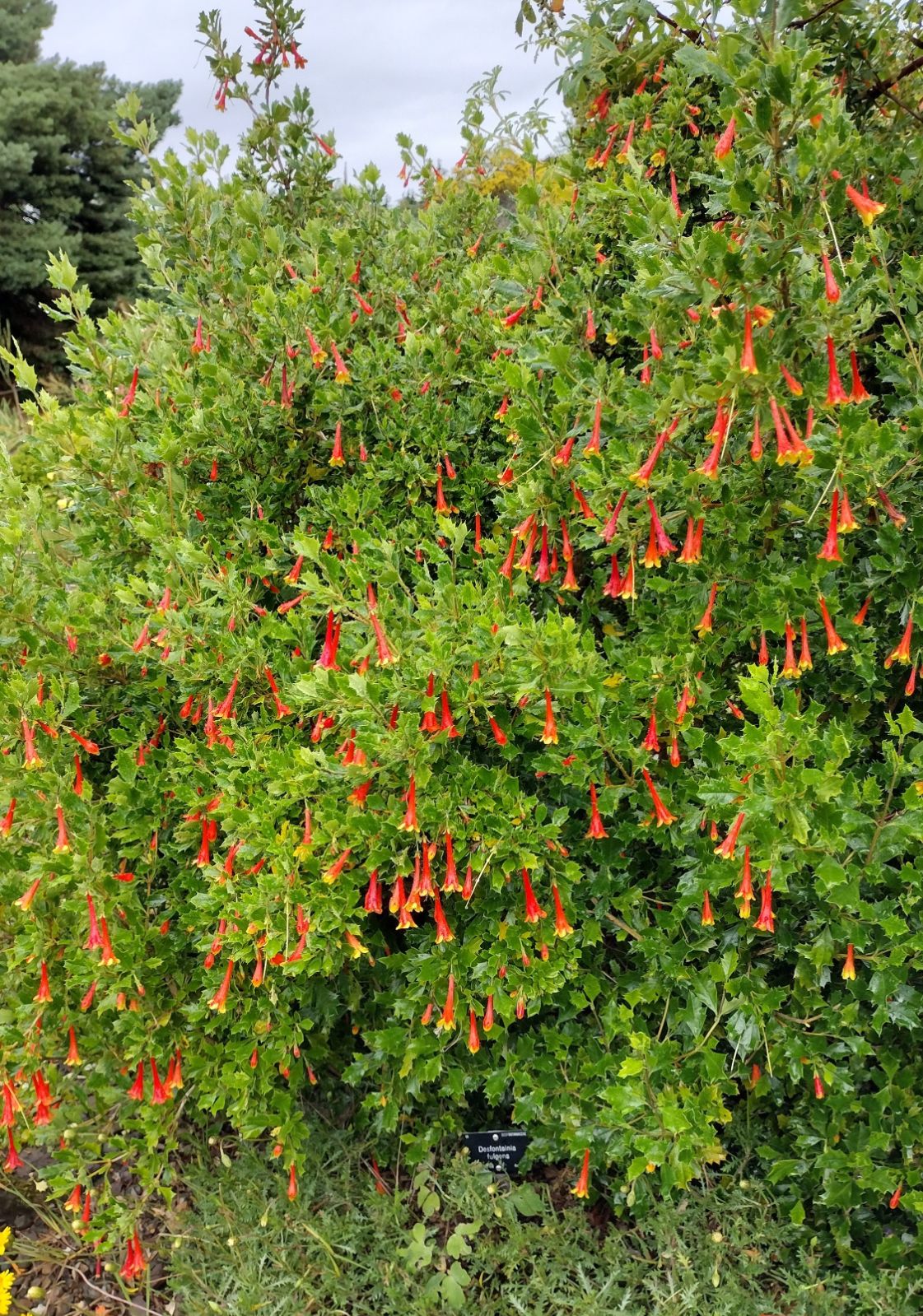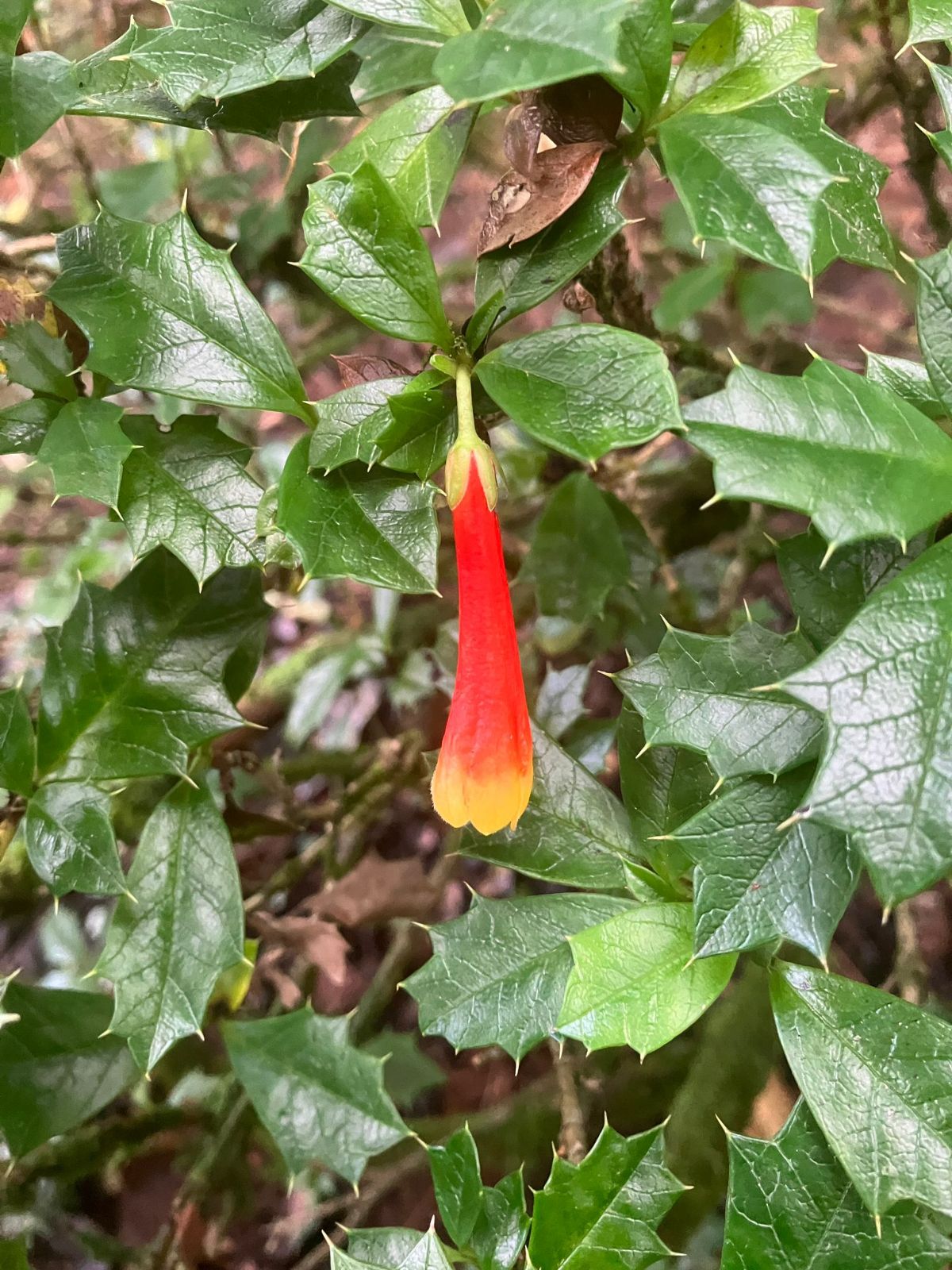Desfontainia fulgens
Sponsor
Kindly sponsored by
a member of the International Dendrology Society
Credits
Martin Gardner & Sabina Knees (2023)
Recommended citation
Gardner, M.F. & Knees, S.G. (2023), 'Desfontainia fulgens' from the website Trees and Shrubs Online (treesandshrubsonline.
Genus
Common Names
- Chilean holly
- Taique
- Chapico
- Michay blanco
Synonyms
- Desfontania chilensis Gay
- Desfontainia ilicifolia Phil.
- Desfontainia spinosa var. chilensis (Gay) Reiche
- Desfontainia spinosa var. hookeri (Voss) Reiche
Large, slow-growing, evergreen shrub 1–4 m. Spreading but sometimes erect. Young branches cylindrical, reddish brown, glabrous, rarely with fine hairs. Leaves opposite, ovate to elliptical, 30–70 mm long, 20–45 mm wide, leathery, strongly undulate, typically shiny dark green above, pale green and dull beneath, veins prominent, holly-like with 3–5 teeth on each side, teeth 4–10 mm long, with a spined tip 2–2.5 mm long. Flower stalks 9–14 mm long; calyx lobes, ovate, 8–9 mm long, 2.5–3 mm wide, finely ciliate along the length of the margin; corolla tube 25–32 mm long, narrowly to broadly conical, stiff and waxy in texture, vermillion; lobes ovate or almost circular, 5–6 mm long and wide, margin densely ciliate, yellow; July–September. Fruit globe-shaped, 15 mm long and wide, fleshy, green, maturing yellowish; seeds, obliquely ellipsoid or ovoid, 2.2–2.4 × 1.2–1.5 mm, smooth, slightly angular, shiny, black. (Leeuwenberg 1969; Weigend 2001; pers. obs.).
Distribution Argentina SW in the Provinces of Neuquén & Rio Negro Chile Central and South Chile
Habitat An undershrub of temperate rainforests from sea-level to 1200 m asl, where at higher altitudes it is exposed to low winter temperatures and is invariably covered by snow for several months of the year. Throughout this distribution it grows in well-drained soils but with high levels of seasonal precipitation. It is a classic associate of Araucaria araucana and Fitzroya cupressoides forests, often forming extensive low thickets, growing with other low shrubs such as Berberis montana, Gaultheria phillyreifolia, Drimys andina and Philesia magellanica. At its higher altitudinal limits the flowers are an important source of nectar for hummingbirds, especially where few other plant species are adpted to hummingbird pollination.
USDA Hardiness Zone 9b
RHS Hardiness Rating H4
Awards Award of Garden Merit 1955
Conservation status Least concern (LC)
Taxonomic note Desfontainia has had a varied taxonomic history. Leeuwenberg (1969) lumped 13 taxa into Desfontainia spinosa Ruiz & Pav and in doing so considered it to have a widespread, disjunct distribution from southern Argentina and Chile to Costa Rica. Schultes (1989) challenged this generous species concept and recognised four species and three varieties, but Leeuwenberg’s treatment of a single species continued to be followed. Most recently, Weigend (2001) argued there was sufficient morphological, biogeographic and ecological evidence to recognise three species, namely D. fulgens D. Don, D. spinosa Ruiz & Pav. and D. splendens Humb. & Bonpl. It is this treatment that is now widely followed, although many nurseries and gardens have been slow in adopting the change from the long-established name D. spinosa to D. fulgens. There are some clear diferences that separate Desfontainia fulgens from D. spinosa. The former has only 2–5 teeth on each side of the leaf margin (vs. 8–10 teeth), the leaf veins on the lower surface are not prominent and usually without coarse hairs (vs. prominent and with coarse hairs on the main veins). There is also a clear difference with the corolla lobes which in D. fulgens they are rounded and 3–4 times as long as the calyx lobes (vs. acuminate and only 1.5–2 times as long as the calyx lobes). The corolla lobe margins of D. fulgens are ciliate and very rarely with coarse hairs on the back, while D. spinosa only has coarse hairs. The distribution of Desfointainia fulgens is restricted to Argentina and Chile while that of D. spinosa is confined to the eastern slopes of the Peruvian Andes.
Desfontainia fulgens was first introduced to cultivation in 1843 by William Lobb, who along with many other plant explorers was employed by the pioneering horticultural firm James Veitch & Sons (Veitch 1906). It first flowered in cultivation in 1853 (Gardner, Hechenleitner & Hepp 2015) when it must have caused quite a sensation with its unusual conical waxy flowers, the like of which would not have been seen before in temperate garden plants. Harold Comber also introduced it in 1927 from Chile, and more recently further introductions have been made from many locations throughout southern Chile as a result of extensive field work carried out by the Royal Botanic Garden Edinburgh from 1991 to 2023. Today RBG Edinburgh cultivates Desfontainia fulgens under eleven accessions but importantly eight of these are of known wild origin (Royal Botanic Garden Edinburgh 2023).
It is frequently cultivated in the UK and Ireland, but the most favourable conditions are to be found along the western seaboard, especially on the west coast of Scotland, Northern Ireland, and in many Irish gardens where relatively cool conditions prevail with high levels of rainfall. Good specimens can be found in many gardens but perhaps the most notable is at Rowallane Garden, Co. Down. This remarkable plant, which was recorded as being 3 m tall and 10 m across (Bean 1988) is sadly now much reduced in stature (see image). In 2016 a large branch of Nothofagus dombeyi unceremoniously fell across it; somewhat ironically that a common associate species in the wild should have been the culprit in the partial demise of this fine specimen. Claire McNally, Head Gardner at Rowallane Garden has reported that although a large proportion of the older, central growth was damaged and had to be removed, it has responded well to pruning with new shoots growing from the branches that were flattened. What remains today, are several discontinuous sections, with the tallest section rising to 3.35 m tall and about the same in circumference but the other sections are generally around 2 m tall. There is one continuous section which is 9.8 m long but not even a metre wide and after that the biggest section is about 5 m long but similarly narrow. Claire says “It is still a fabulous plant but less impressive than it was when Bean visited the garden!”
There are good examples of it flourishing in an exposed position in the South American beds of the rock garden at the Royal Botanic Garden Edinburgh. However, in very cold locations it is best afforded winter protection in woodland conditions. It is less common in Europe where it is best suited to the wetter regions of northern countries. It is sometimes cultivated in New Zealand and occasionally in the wetter climates of Western North America. It rarely sets seed in cultivation and this may be in part due to nectar-robbing bees accessing the nectar by biting through the tissue wall at the base of the corolla tube and therefore circumventing the usual pollination process.
The range of flower shapes can vary from very broad to quite narrow and many colour variants concerning the amount of yellow in proportion to scarlet or vermillon has surprisingly not given rise to more cultivars being named. Note that in many individuals as the flowers mature the entire corolla-tube gradually changes to vermilion or dark red and therefore it loses the distinct yellow lobes (pers. obs.) Two are treated here (see below).
When available, seed should be autumn-sown in a moist compost, or even within a layer of sphagnum moss and protected from cold weather. Propagation records from RBG Edinburgh show that seed collected from Chile in late summer take 3–4 months to germinate but with germination rates of less than 30%, which is probably due to high levels of seed being predated in Chile (pers. com. P. Brownless). The best and most reliable propagation method is to take semi-ripe cuttings from July to August (UK) placed in a well-drained medium with gentle bottom heat; these will take 6–8 weeks to root. Thankfully, Desfontainia seems to be generally pest and disease free.
Carlos Mariani (Bello 1965) reports that Desfontainia fulgens is used as narcotic and stomachic and is utilized by the the indigenous Mapauche people of Chile. He also makes reference to the leaves that are as bitter as gentian and that the local Mapuche use them as a source of yellow dye in their textiles. The local vernacular name ‘taique’ means shiny in reference to the glossy leaves; ‘chapico’ means ‘chilli water’, alluding to the plant’s hot and bitter tasting leaves (Baeza 1930).
'Firecrown'
It is proposed to name the plant on the Rock Garden at RBG Edinburgh (accession number 20040034*A) Desfontainia fulgens ‘Firecrown’. This plant has very narrow corolla tubes that are predominantly vermillion and flared towards the end with yellow. The name ‘Firecrown’ celebrates the remarkable Green-backed firecrown (Picaflor chico), a common humming bird species responsible for pollinating the flowers of Desfontainia and many other rainforest species in Chile and Argentina. The plant was raised from seed collected in 2003 under the field number DCI 159 from Reserva Nacional Los Ruiles in Chile’s Maule Region. This narrow corolla form is commonly encountered throughout the distribution of the species in Chile.
'Harold Comber'
Synonyms / alternative names
Desfontainia fulgens Comber's Form
Awards
AGM
A plant selected at Nymans Garden in Sussex, UK, from seed collected in Chile by Harold Comber in the early 20th century (Comber 560), was appropriately named for him and given an RHS Award of Garden Merit in 1955. This is sometimes simply referred to as ‘Comber’s Form’. Its flowers are broadly tubular with shades of vermillion to orient red (Edwards & Marshall 2019).



